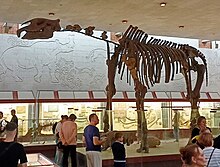
Back كركدنينات Arabic Rinocerotoïdeus Catalan کرگدنواران Persian Rhinocerotoidea Finnish Rhinocerotoidea French קרנפים (על-משפחה) HE Rhinocerotoidea Italian サイ上科 Japanese Rhinocerotoidea Dutch Rhinocerotoidea NB
| Rhinocerotoids Temporal range: Latest Paleocene-Present
| |
|---|---|

| |
| Rhinoceroses, a type of rhinocerotoid | |

| |
| Skeleton of Paraceratherium (Paraceratheriidae) | |
| Scientific classification | |
| Domain: | Eukaryota |
| Kingdom: | Animalia |
| Phylum: | Chordata |
| Class: | Mammalia |
| Order: | Perissodactyla |
| Suborder: | Ceratomorpha |
| Superfamily: | Rhinocerotoidea Gray, 1821 |
| Families | |
Rhinocerotoidea is a superfamily of perissodactyls that appeared 56 million years ago in the Paleocene. They included four extinct families, the Amynodontidae, the Hyracodontidae, the Paraceratheriidae, and the Eggysodontidae. The only extant family is the Rhinocerotidae (true rhinoceroses), which survives as five living species. Extinct non-rhinocerotid members of the group are sometimes considered rhinoceroses in a broad sense. Although the term 'rhinoceroses' is sometimes used to refer to all of these, a less ambiguous vernacular term for this group is 'rhinocerotoids'. The family Paraceratheriidae contains the largest land mammals known to have ever existed.[1]
- ^ Deng, T.; Lu, X.; Wang, S.; Flynn, L. J.; Sun, D.; He, W.; Chen, S. (2021). "An Oligocene giant rhino provides insights into Paraceratherium evolution". Communications Biology. 4 (1): 639. doi:10.1038/s42003-021-02170-6. PMC 8211792. PMID 34140631.